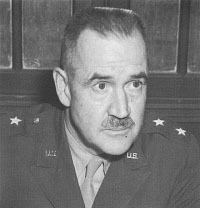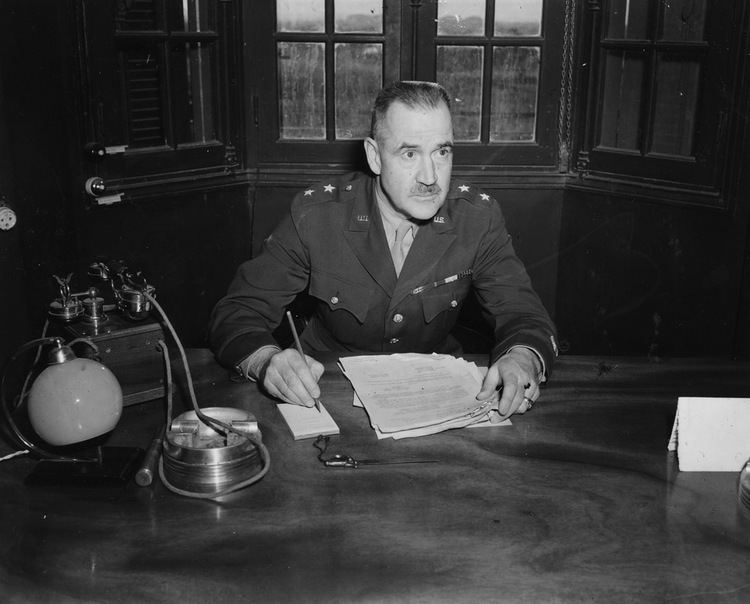Nickname(s) "Mike" Name Ernest Dawley Years of service 1910 - 1947 | Rank Major general Service number 0-2843 | |
 | ||
Born February 17, 1886Antigo, Wisconsin ( 1886-02-17 ) Commands held 82nd Field Artillery Regiment (1939)Division Artillery, 7th Infantry Division40th Infantry Division (September 1941-April 1942)VI Corps (April 1942-September 1943)US Army Tank Destroyer School (1943)US Army Tank Destroyer Center (1944)Ground Forces Reinforcement Command, European Theater of Operations (1945) Battles/wars World War IWorld War II Awards Distinguished Service Medal, Silver Star, Legion of Honour | ||
Allegiance United States of America | ||
Major General Ernest Joseph "Mike" Dawley (February 17, 1886 – December 10, 1973) was a senior officer of the United States Army, best known during World War II for commanding the U.S. VI Corps during Operation Avalanche (the landings at Salerno). After the landings, he was relieved of his command by Lieutenant General Mark Clark, commander of the U.S. Fifth Army, and returned to the United States.
Contents

Early life and military career
Dawley was born on February 17, 1886 in Antigo, Wisconsin. After graduation from the Ribbon College in Ripon, Wisconsin and subsequently entered the United States Military Academy (USMA) at West Point, New York in 1906, at the age of 20. He graduated four years later on June 15, 1910 and was also commissioned as a second lieutenant into the Field Artillery Branch of the United States Army on that date. Among his fellow graduates included Jack Heard, Emil F. Reinhardt, John Millikin, James Muir, Oscar Griswold, Jack McCoach and Lewis Burton. He served in both the United States and in the Philippines, attending various schools. He took part in the Mexican Punitive Expedition in 1916, serving under the command of Brigadier General John Joseph "Blackjack" Pershing.
With the American entry into World War I, which occurred in April 1917, Dawley was transferred to the newly created 7th Field Artillery Regiment stationed at Fort Sam Houston, Texas. The 7th Field Artillery was assigned to the 1st Infantry Division. Together with his division Dawley, by now a captain (having been promoted in May), was sent to the Western Front as part of the American Expeditionary Force (AEF), which was commanded by John Pershing, who Dawley had served with in Mexico the previous year.
After arrival in France, Dawley attended a short course in l’Ecole d'Artillerie at Fontainebleau and was appointed the executive officer (XO) for the Saumur Artillery School. He was promoted to major in February 1918. He stayed in this capacity until May 1918, when he was transferred to the 12th Field Artillery Regiment, part of the 2nd Infantry Division. For his service with the 12th Field Artillery, Dawley was decorated with the Silver Citation Star for gallantry in action near Vierzy, France.
At the end of July 1918, he was transferred to the General Staff of the U.S. First Army. He was also promoted to the rank of lieutenant colonel in this capacity. He was briefly assistant chief of staff for the field artillery of the U.S. Second Army. During this assignment the war ended, on November 11, 1918. On November 20 he served with the 16th Field Artillery Regiment, part of the 4th Infantry Division.
Between the wars
Dawley remained in the army after the war, which ended on November 11, 1918, at 11:00am, and in the subsequent interwar period.
World War II
In 1940, during World War II (although the United States was still officially neutral at this stage), he became the commander of the artillery of the 7th Infantry Division, commanded by Major General Joseph Stilwell. In September 1941 Dawley took command of the 40th Infantry Division, an Army National Guard formation. December 1941 saw the American entry into the war, due to the Japanese attack on Pearl Harbor.
In April 1942 he was promoted by his close friend, Lieutenant General Lesley J. McNair, the commander of Army Ground Forces, to command of the VI Corps. The corps was, in early 1943, sent to the Mediterranean Theater of Operations (MTO), initially to participate in the Allied invasion of Sicily, where it was to come under command of the U.S. Seventh Army, commanded by Lieutenant General George S. Patton. However, Lieutenant General Omar Bradley's II Corps, which had been in action in the Allied campaign in North Africa, was chosen instead.
The VI Corps was instead selected for participation in the Allied invasion of Italy, coming under command of Lieutenant General Mark W. Clark's U.S. Fifth Army. The relationship between Clark and Dawley was not always easy, with Clark being a decade younger than Dawley and less senior. The 36th Infantry Division, under Major General Fred L. Walker, and the 45th Infantry Division, under Major General Troy H. Middleton, both National Guard divisions, were under command for the operation. Both Walker and Middleton had, like Dawley, seen fought in World War I. The corps took part in the Allied invasion of Italy at Salerno on September 9, 1943, with the British X Corps also under Fifth Army command, as part of Operation Avalanche. The stiffness of the German defences sorely tested VI Corps, inflicting heavy casualties. German attempts to throw the American force back into the sea were thwarted by the artillery of both divisions, strongly supported by naval and aerial bombardment and the approach of the British Eighth Army from the south.
Although thought highly of by many officers, Dawley had been moved on by Patton in Sicily (although this was mainly due to Patton wanting an experienced corps commander) and his suitability for high command had been questioned by the Supreme Allied Commander in the MTO, General Dwight D. Eisenhower, and British General Sir Harold Alexander, the 15th Army Group commander, who described Dawley as a "broken reed". After the problems at Salerno, during which Clark brought in Major General Matthew Ridgway, commander of the 82nd Airborne Division, to act as the VI Corps deputy commander, Dawley was replaced by Clark after Salerno, as he was judged to be "worn out", although many, including both Walker and Middleton, along with Colonel James Gavin, commander of the 505th Parachute Infantry Regiment, believed Clark to be finding a scapegoat to cover his own failures and thought Clark should be the one to go. He was replaced as VI Corps commander by Major General John P. Lucas, who, ironically, was also replaced in February 1944 during Operation Shingle.
He returned to the United States and reverted to his permanent rank of colonel on December 23, 1943 and was assigned as the commander of the Tank Destroyer School and Center in the United States, the first of several appointments to military training establishments. Some sources say that he was subsequently promoted to brigadier general on September 30, 1947. However, the "Biographical Dictionary of World War II Generals" states that he was "Commanding general" of the Tank Destroyer Center from February 1944-March 1945."
Postwar
He retired from the army after the war in 1947 and was given the rank of major general (Retired) on June 29, 1948.
Postwar
Major General Ernest Joseph Dawley died on 8 September 1973 at Silas B. Hays Army Hospital at Fort Ord, California, almost exactly 30 years since the Salerno landings. His body was cremated and ashes scattered at sea.
Decorations
Here is the ribbon bar of Major general Dawley:
